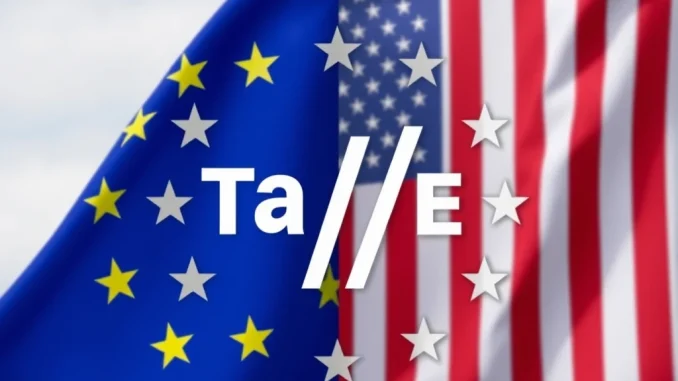
Hold onto your hats, folks! The global trade landscape is about to get a whole lot more interesting, and potentially turbulent. The European Union has just dropped a bombshell, proposing significant EU tariffs on a range of US imports. This isn’t just a minor trade dispute; it’s a potential escalation that could ripple through global markets. Let’s dive into what’s happening and what it could mean.
What Exactly are These EU Tariffs on US Imports?
In a move that has certainly raised eyebrows across the Atlantic, the European Commission has announced plans to impose a hefty 25% tariff on various goods coming from the United States. These aren’t just symbolic gestures; these are substantial financial penalties that could significantly impact businesses on both sides of the pond. The first wave of these EU tariffs is slated to kick in on May 16th, with a second round planned for December 1st, according to reports from Odaily News.
But why are these tariffs being introduced? What’s the backstory here? Let’s break it down:
- Retaliatory Measure: These tariffs are being positioned as a direct response, or retaliatory tariffs, to actions taken by the United States. While the specific US actions haven’t been explicitly detailed in the initial reports, it’s crucial to understand that trade disputes are rarely one-sided.
- Phased Implementation: The two-phase rollout – May 16th and December 1st – suggests a strategic approach. It could be designed to exert pressure incrementally or to allow time for negotiations and potential de-escalation.
- Broad Range of Imports: The announcement mentions “a range of US imports,” indicating that these tariffs won’t be limited to a narrow category. This broad scope implies a potentially significant economic impact across various sectors.
Is This the Start of a Trade War?
The phrase “trade war” is often thrown around, and it can sound alarmist. But in this situation, it’s a question worth asking. While it’s too early to definitively declare a full-blown trade war, the imposition of significant tariffs is undoubtedly a major escalation in trade tensions.
Here’s why this situation is concerning and could potentially spiral into a larger trade war:
- Escalation Risk: Tariffs often lead to retaliatory tariffs. If the US responds to these EU tariffs with its own set of tariffs, we could enter a cycle of tit-for-tat measures, harming businesses and consumers on both sides.
- Economic Uncertainty: Trade wars create uncertainty. Businesses become hesitant to invest, supply chains are disrupted, and consumers may face higher prices. This uncertainty can negatively impact economic growth.
- Global Impact: A trade war between two major economic blocs like the EU and the US wouldn’t just affect them. It would have ripple effects across the global economy, impacting other trading partners and international markets.
The European Commission’s Perspective: Why Retaliatory Tariffs?
To understand this situation, it’s essential to consider the perspective of the European Commission. They are the executive branch of the EU, responsible for proposing and implementing legislation, including trade policy. When the European Commission proposes retaliatory tariffs, it’s typically based on a rationale of defending European interests.
Possible reasons behind the European Commission‘s move could include:
- Dispute Resolution Failure: International trade disputes are often addressed through mechanisms like the World Trade Organization (WTO). If the EU believes that diplomatic efforts or WTO processes have failed to resolve a trade issue with the US, tariffs may be seen as a necessary tool.
- Protecting EU Industries: Tariffs can be used to protect domestic industries from what is perceived as unfair competition or harmful trade practices from other countries. The European Commission might argue that these tariffs are needed to safeguard European businesses and jobs.
- Leverage for Negotiation: Sometimes, tariffs are used as a bargaining chip. By imposing tariffs, the European Commission might be aiming to pressure the US into negotiations and concessions on other trade-related matters.
What are Retaliatory Tariffs and How Do They Work?
The term “retaliatory tariffs” is central to this news. So, what exactly are they? Essentially, retaliatory tariffs are tariffs imposed by one country in response to tariffs or other trade restrictions imposed by another country. They are a tool used in international trade disputes as a form of economic pressure.
Here’s a simple breakdown of how retaliatory tariffs generally work:
- Initial Trade Action: Country A imposes tariffs or trade restrictions on imports from Country B.
- Retaliation: Country B, feeling aggrieved by Country A’s actions, decides to retaliate by imposing its own tariffs on imports from Country A. These are the retaliatory tariffs.
- Escalation (Potential): Country A might then respond to Country B’s retaliatory tariffs with further trade measures, and the cycle can continue, potentially escalating into a trade war.
In the current scenario, the EU’s proposed 25% tariffs are the retaliatory tariffs, responding to as-yet-unspecified trade actions from the US.
Potential Impacts of These Tariffs
The imposition of EU tariffs on US imports will have a range of consequences. While the full scope will depend on the specific goods targeted and the duration of these tariffs, here are some potential impacts:
- Increased Costs for Businesses: US companies exporting to the EU will face higher costs due to the 25% tariff. This could make their products less competitive in the European market. European businesses importing from the US may also face higher input costs.
- Consumer Price Hikes: Ultimately, tariffs can translate to higher prices for consumers. If businesses pass on the tariff costs, European consumers may pay more for goods imported from the US.
- Trade Diversion: European businesses might seek to source goods from countries other than the US to avoid the tariffs. Similarly, US businesses might look for alternative markets outside the EU. This can disrupt established trade flows.
- Economic Slowdown: Widespread tariffs and trade tensions can dampen economic activity. Reduced trade and investment can lead to slower economic growth in both the EU and the US, and potentially globally.
- Political Fallout: Trade disputes can strain political relationships between countries. This tariff move could further complicate EU-US relations.
What Happens Next? Actionable Insights
For businesses and individuals watching this situation unfold, here are some actionable insights and things to consider:
- Monitor Developments Closely: Stay informed about further announcements from the European Commission and the US government. Trade policy can change rapidly, and it’s crucial to have up-to-date information.
- Assess Business Impact: Businesses that trade between the EU and the US should immediately assess how these tariffs might affect their operations, supply chains, and profitability.
- Prepare for Contingencies: Companies should consider developing contingency plans. This might include diversifying supply chains, exploring alternative markets, or adjusting pricing strategies.
- Advocate for Dialogue: Businesses and industry associations can play a role in advocating for diplomatic solutions and the de-escalation of trade tensions.
- Consider Investment Strategies: Investors should be mindful of the potential economic uncertainty created by trade disputes and factor this into their investment decisions.
In Conclusion: A Critical Juncture in EU-US Trade Relations
The EU’s proposal to impose 25% EU tariffs on US imports marks a significant and potentially critical moment in transatlantic trade relations. Whether this is a calculated move to de-escalate tensions through negotiation, or the first shot fired in a damaging trade war remains to be seen. The coming weeks and months will be crucial in determining the trajectory of this trade dispute and its broader impact on the global economy. One thing is clear: businesses and consumers alike need to brace themselves for potential shifts in the trade landscape and the economic ripples they may create.



